It is said that a picture is worth a thousand words. Well I could probably write a thousand words on this subject but I won’t, I’ll spare you all and keep it compact – the images do most of the talking. Anyway, what we have here is a 1963 Porsche 356 B that got taken out by an engine fire – how unfortunate! It’s not completely destroyed, but as the seller states, “This would make a good project if you wanted to put in the work, it will need a lot of work…” OK, let’s see what’s still here, this “red hot” deal is located in Ravena, New York, and is available, here on eBay for A BIN price of $23,500. There is a make an offer option too. Thanks go to T.J. for finding this three alarmer!
So what exactly happened isn’t stated but you know, gasoline and a spark is how the whole shebang works – it’s just supposed to happen inside of the engine and not in the engine compartment. The 1.6-liter flat four-cylinder engine is shorn of its carburetors, air cleaner, wiring, belt, and probably a lot of other components too. It’s not said if the engine is salvageable, as is, or if it will need a complete teardown and rebuild (probably the latter).
As for the body, the rear half took the brunt of the inferno. That said, on the surface, it still looks reasonable. The hood’s (bonnet?) air vents are gone and there never was a rear bumper (the seller opines, “Before the fire, it was heading up and down the road looking like an outlaw with the Carrera rear valance and the shaved bumpers. It was a cool car”). The side glass appears to be a victim and the paint, even extending most of the way forward, is cooked. One has to wonder about the rear body’s integrity after being exposed to that much heat. Note the now exposed rear valance seam “stitching”.
So much for having a hot time in the old town tonight! Save for a steering wheel and a gear shifter, the interior is gutted – there’s nothing left. Fully decked out, these interiors are not a complicated environment but when one has to completely rebuild it from scratch, you just know that it’s going to be a substantial and expensive undertaking.
The seller states that he still has the title but he expects that the insurance company will issue a salvage title attached to the VIN so that probably limits forward directions one could take with this torch wagon. The seller suggests what’s left, and what you see is all there is, would be a good basis for a race car. It’s really a shame, I’m glad to know that this 356 was insured and the insurance company paid. I wonder if a fire extinguisher was anywhere near at hand, or would it have even mattered? Regardless, can you imagine watching your prized Porsche go up in smoke and all you can do is snap a picture?



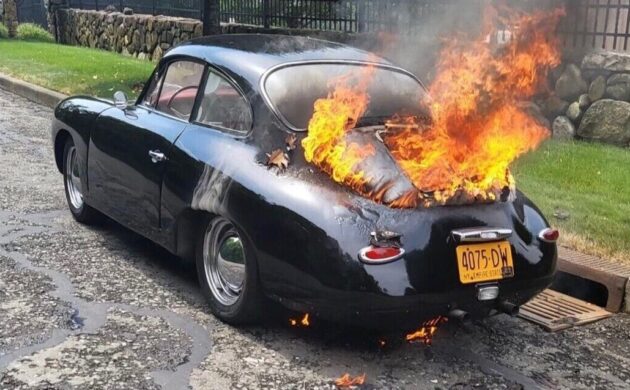
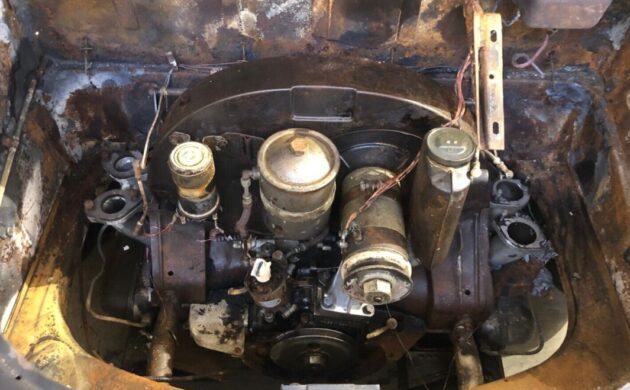
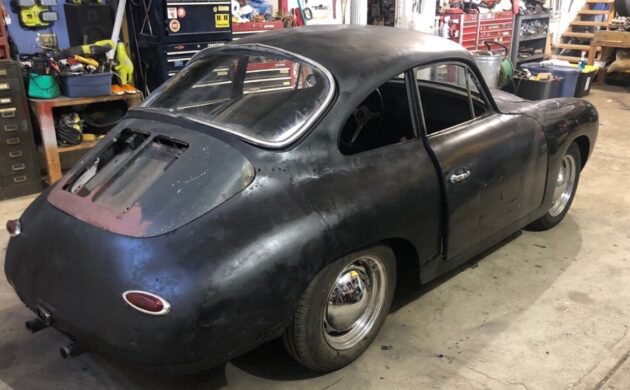
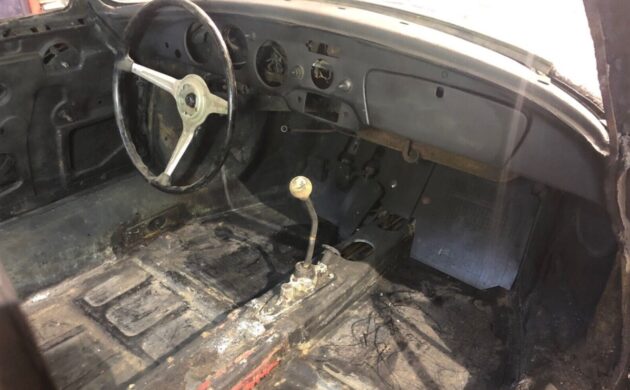
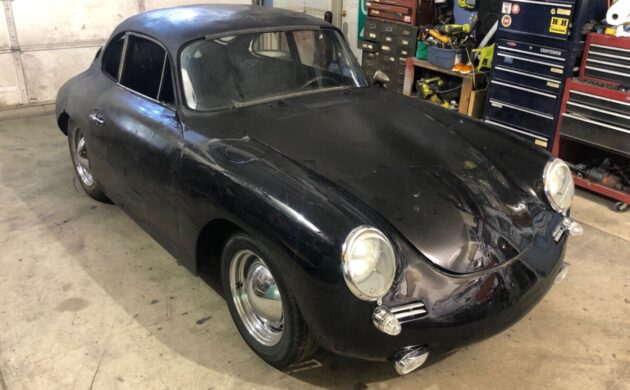



So sad. I’m sure tears were shed over that tragedy. I know I would have anyway.
Metal on these cars is thick and hard so that kind of heat isn’t going to have much effect on it. Engine is one of the Supers with the big Solex carbs. Looks like the manifolds are OK but pulling the heads to check the valves needs to be done. Think I’d buy this one back from the insurance company.
Fire extinguisher used to be standard equipment on any modified or older cars back in the day. I myself never had to pull mine but did use a rag now and then. Don’t see the smaller vehicle extinguishers any more except marine use and they have marine prices. Take note folks, your car can burn. Then learn how to use one, might have saved this one. No not fireman Dan here just an old guy that has had many carbureted cars and lines and floats can fail.
So true and a eye opener for me. My 65 Corsa has 4X the potential fuel leak potential. Fortunately GM used steel fuel lines in the engine compartment. However the one month old garbage China fuel pump literally squirted me in the eye while I was synchronizing the carbs. Luckily I was not driving it when it happened.
We did a lot of work moving Porsche 911 and 914 fuel pumps from the engine compartments up to the front close to the fuel tank. Steel braided fuel lines also helped in insuring the cars weren’t going to be crispy critters. the 356s can be done the same way but the purists think it will never happen to them. Our twin carb race engines have short rubber lines from the carbs to the fittings at the junction of the braided line from the tank and fuel pumps in the rear. We also have a fire system plus an extinguisher in the race cars. Continually checking the rubber lines for wear is paramount. We have extinguishers in all our vehicles. In the ’70s a lady with a four carb Corvair drove past the house slowly with fire coming out of the engine compartment. Gabbed the extinguisher out of the Blazer, got her stopped and put out the fire. Nothing much damaged but found her husband had disconnected the throttle linkage to one carb on each side to “save fuel”. Guess where the fuel went on those two carbs. Pulled and blocked the lines and sent her on the way suggesting she get her own extinguisher.
As part of the “emergency response team” for my office I, and a number of other employees got lessons on proper use of a fire extinguisher from professional firefighters. I would recommend everyone take a similar course if you intend to buy/use an extinguisher. It is more than just aiming and pulling the trigger of the extinguisher. What you should do is aim at the base of the fire and, with the extinguisher firing, sweep horizontally from side to side. This will put out most fires (if you have the right kind of extinguisher for the type of fire). Just aiming at the fire in general MIGHT do the same thing but there is no guarantee. The method I was taught is much more likely to do the job. Again, taking a course is my recommendation.
You can do anything you want to a salvage vehicle in New York. But you have a salvage title when you’re done.
I keep fire extinguishers in all my vehicles.
A few weeks ago, my wife and I were in our ’66 C2 427 4-spd convertible on the way to coffee and cars. We were just a few miles from home, doing about 50 MPH on a secondary highway, when we both suddenly smelled raw fuel. I began to prepare to pull over, and WOOF, the engine compartment burst into flames. I braked hard and pulled over with fire blazing out the side vents and around the hood. I grabbed the fire extinguisher, opened the hood and was able to quickly quench the flames.
The rubber fuel line apparently failed near the filter at the front /top of the engine, and sprayed the engine compartment with gasoline.
Luckily it happened infront of a friends house, and we got a ride home to get our car hauler.
After replacing ALL the rubber fuel lines, filter ,and some wires, I had the car running the next morning. Several sessions with various cleaners, and a big pressure-washer revealed relatively little paint damage . The car was a barn-find that we did frame-off resto 6 years years ago. We rebuilt the drivetrain to mostly NCRS standards, but chose to leave the body “as found”, with lots of pealing paint and patina. The lightly bubbled and discoloured paint around the fender vents is now just another part of the car’s story.
To be safe, I replaced the entire wiring harness from the firewall forward to include all lighting.
The ’66 is one of our favourites, and we were very happy to be able to save it.
As for the 356 for sale, a fire extinguisher would likely have saved it, keeping the damage to a minimum. In that it was insured, the owner was probably able to keep it under a “cherished salvage” clause. Hagerty charges about $30 for this, which means if your car is a total loss, you can still keep it and be paid out.
Why would you have rubber fuel lines on a 66 Corvette? Chevrolet used formed steel lines from the pump to the carb on all Corvettes.
66’s used a single steel line on 427/390’s, and 3 lines and a “Y” block on the 427/425’s dual feed Holley. Perfect reproductions are readily available, and cheap. There is no reason to use rubber fuel lines on any old Corvette.
Who mentioned anything about a Corvette? This is about a 1963 German Porsche 356B. ?????
Thanks for sharing the tips and the story – leaving burnmarks? Me gusta!
A salvage title will at least allow you to title and register a car for the road.
Typically though, the insurance might issue a “Certificate of Destruction” which proves ownership, but the vehicle can never to be licensed or titled…for all of eternity.
Ask me how I know……
Not in NY, that I’m aware of.
No vehicular titles in NY until 1973.
HD
that would have required therapy for me …….
There are two types of German air-cooled engines: those that have caught on fire, and those that have yet to catch on fire.
That’s bull.
Actually jw, G Lo’s comment is very accurate. Ones that HAVE and ones that have NOT. The inference is that German air-cooled cars DO tend to have more fires than German water-cooled cars. Sadly, I have to agree, because I like German cars.
Between the cars I have owned and those we worked on in my shop, I can say that of the VW, Porsche, Isetta, DKW, Trabant [and while technically Czech], my Tatras as well. Many of those cars had been the victim of an engine fire over their lives.
However I cannot remember ever having a water-cooled German car where it had an engine fire, not my personal cars, nor those in my shop.
@jw-if you didn’t enjoy that joke, you will be thoroughly unhappy with my Lucas Electric “Prince of Darkness” routine.
G Lo,
Ahhh Yesss, Joseph Lucas. Many years ago I read a biography of the man and the company, and I wrote a book report about it for one of the British car clubs. I suggested the book was best read by daylight.
Many Americans probably don’t know about Lucas wiring harnesses on vehicles. Before WW2, they used only black wiring, no color codes. They depended on little metal clips fastened at both ends of a wire. Each pair of clips had a specific number to identify the wire. You then had to look up the wire number in the wiring diagrams published by Lucas. Problem was, if you had to trace a specific wire thru the loom, it was very difficult. My first experience with this situation was when I was restoring a 1935 Rover 12 drop-head, and there was no numbering info available in the USA 40 years ago.
This all black wiring probably led to the claim that Lucas hired the disabled to build the harnesses, employing color-blind workers!
Hanging up in my warehouse is a lovely poster showing a 1930s English lady using a Lucas Vacuum Sweeper in the parlor. The caption really says: You know it’s Lucas, It Sucks!
Keep an extinguisher in the car! A while back, a guy by the side of the road was throwing dirt on an engine fire. I whipped out my 3 lb dry chemical extinguisher and it put out the fire, but not before the hoses blew, and covered us in rusty red radiator water!
Ethanol fuel rotted out the old rubber hoses or rubber diaphragm in the pump?
Had a 66 SS396 Chevelle back in the day. Had a Holly 4bbl single line carb that used a tube with “o” rings on each end to feed the other fuel bowl. “O” ring failed and fire ensued. All I had was a blanket (all teenagers have blankets in their car) and that got it out. No major damage.
Not a bad idea actually, the blanket deprives the fire of the oxygen it needs to burn. Yank it off quickly so the blanket itself doesn’t start burning and it could do the trick. Think I’ll put a thick moving type blanket in my trunk.
Not surprised to see this happen to a Porsche. Volkswagens are notorious for engine fires, to the point that owners often equip them with a ring shaped “automatic” fire extinguisher mounted over the motor. Most serious bus owners wouldn’t be caught without one.
The Porsche, unlike the VW, used solid metal lines and banjo fittings for most of the fuel lines. The VW used the braided hose. AND there are the (insert word meaning lack of intellectual ability) who place a plastic fuel filter in the hose between the pump and the carburetor. WHEN it comes loose or fails, the fuel rains down on the nice sparky distributor. (insert frantic running and arm waving) There is a filter screen in the VW pumps. Anything that passes that screen will pass though the carb without issue making the added filter LESS than worthless.
The other place the VW fails is where the metal fuel tube goes forward though the rear tin. The grommet fails and the tube rubs though on the vibrating edge of the tin. In this case the fuel rains down on the exhaust stub for #3 cylinder. On a bus, that failure will empty the whole tank onto the fire.
Porsche’s pretty rare to start on fire unless eng mods were done. I had English cars for a bit, carried 2-extinguishers and a tow strap in each. No problem…
If you are going to spend big bucks on a car, spend a few more and purchase a Halon extinguisher. On most cars, and particularly air cooled cars, you do not want to open a burning engine compartment. You also may not be able to. The halon aimed though a radiator or an air vent will get pulled in by the draft and shut the fire down. Dry chemical needs to have a direct shot at the base of the flames to work. Also, the dry chemical requires quick clean up as it corrodes many metals if left on the surface. I carry both types in my vehicles. My electric car? I carry my cell phone and if the car should catch on fire, I take it as I exit the car and call the fire department as I walk over………………………………………………………………..here to avoid the smoke and flames.
I’m not entirely sure but certain states will allow a Salvage/Branded title to be changed if the vehicle meets an visual inspection.
A while back, my mechanic/body shop had an otherwise drivable, auction Mercedes’ wreck that they repaired after the insurance company totaled it due to cost of the oem replacement parts. He was able to cobble together all the pieces from other wrecks. Had it shipped to Colorado for inspection and applied for it to be re-titled – so he said, whether it was now a Rebuilt title or Regular title is unknown. Some states allow for Title Only registration application for out-of-state owners.
In the case of regular cars, a branded title of any sort affects the resale/trade/actual replacement value, financing and maybe safety issues for insurance. A classic I don’t think it matters, especially when there’s provenance showing the damage before, during and after the repairs.
If this car was in an episode of CHiPs when the fire occurred, it would have blown up, guaranteed. But, 7-Mary-3 and 7-Mary-4 would have pulled all the passengers out right before that happened, and I do mean RIGHT before.
After watching CHiPs, I always figured that cars in California are required to drive around with ramps bolted to the side. In ANY collision, one of the vehicles had to fly though the air OVER the other traffic before exploding. It’s on TV it must be real…just like the internet…..
Wow – people were “talky” on this thread! Lots of good information, tho.
You must be new here. Welcome, and be prepared to do “talky”
Been here a long time and there’s usually one or two long responses – but more than usual for this little bathtub Porsche. I’m not complaining. I learned some things!
I keep one within reach in my 66 Corvette. Have had the Holley leak onto the hot engine, luckily didn’t ignite. Have had many carb flare ups over the years, and a battery explosion, but thank God nothing serious. I want to keep it that way!
Stay tuned for an appearance from Astoria, NY any day now.
Was it also pinstriped?
Interesting, with flames pouring from the engine compartment, taking a picture was the priority? Speaking from experience, had an engine fire in my 69 H/O.
A picture was not at the top of my to do list!!
Doug, Take it from someone who has been the victim of several big fires, unless you have a fireman with a hose right there, this fire is well-established to the point that you can only wait for the fire dept you already called, then might as well document what happened using your phone.
That car is hot!
The featured pic has some manipulation and may not be of the original fire. Regardless, it looks like a decent project. How are the side windows gone and the rear ok?
I don’t see any evidence of manipulation in the photo, and the window in the “after fire” appears to be just sitting on the pinchweld, without the gasket. It is likely a replacement window and trim. The “after” photo’s seem to show considerable cleanup has taken place, the side windows may have been damaged, or they were removed to to get the burned gaskets off the car. Sold for $20k!
During the 80’s, I sold a lot of Weber carburetor conversions. To be a certified CA legal replacement carburetor, the fuel inlet brass hose barbs had to be threaded into the carburetor. Here is the counterintuitive, yet FLAMING example of Solex, and many other OEM carburetor’s design flaw. Typically, the brass fuel inlet pipe was a brass tube having a “round oversized fuel line retaining tip”, The straight unthreaded tubular end was simply press-fit into the die-cast carburetor body. The fuel line of the era was a “push-on cloth braided type” having a specific cloth woven exterior that acted like a “Chinese finger trap”, and in many cases was simply pushed on sometimes using a “spring hose clamp”. YET- upgrading to a screw-on mini-hose clamp actually CAUSED disaster! Tightening a hose clamp onto the hose over the brass inlet tube at the space between carb body and the rounded oversized tip of the brass inlet pipe made a perfect “squeeze puller tool” and pulled the brass right out of the carb body over short time. It was the perfect accident waiting for a place to happen! Ask me about the infamous Eberspacher gasoline heater. I own several along with their Molotov stories.!
As a former Fire Fighter and 6+ years selling and recharging fire extinguishers, I found the advice on how to SAFELY put out an engine fie to be solid. Lifting the hood while an engine is on fire can kill you. Super heated parts such as fuel pump, carburetor, P.S. pump, or battery can overheat and explode sending shrapnel everywhere including someone’s face. Not to mention the inrush of oxygen from opening the hood will cause the fire to flare up and can seriously burn you. With a dry Chemical extinguisher aim through radiator first / or you can aim upward from under engine compartment to reduce flames before cracking (slightly opening) hood
then aiming at base of fire sweep the chemical back and forth to extinguish fire. Recommend B&C class extinguishers for automotive. CO2 & Halon are also good for automotive fires. Class A should be kept in home as it will melt and is difficult to remove residue.(Note: While Halon extinguishers are great for putting out engine fires, they are expensive and can’t be refilled everywhere.)
George, serious question regarding this discussion. One of my cars is a Corvair, with an essentially sealed engine compartment except for the air intake grille at the base of the rear window. There is no direct path to the engine compartment due to design that minimizes water intrusion. I am familiar with how to use extinguishers, but what would you recommend in a case like this?
Halon 1211. The bigger the better. Yeah..they are expensive but how much is your car worth?
My background is aircraft fire suppression. The stuff works….
steve is correct. You need a gas type extinguisher, assuming the motor is running when you need to use it. Don’t turn the engine off if you see evidence of a fire back there. With the motor running, there is a very large draft of incoming air into that engine compartment. I would aim that gas extinguisher at all points of that intake grill, basically giving it the Halon gas instead of oxygen. If the engine stops running because of the Halon gas, that’s OK because you know that the gas has done it’s job. Then DO make sure the ignition is turned off, and when safe to do so, disconnect the battery.
But you will need to act quickly if the Halon gas is to work correctly. Don’t make 2 common mistakes I see at car shows: [1] The extinguisher buried in the trunk, and [2] the extinguisher mounted to a bracket in the engine compartment where you cannot reach it if the motor is on fire!
My 1962 Tatra has an air-cooled V8 in the back. Attached to the right side of the engine compartment is the factory installed CO2 extinguisher. It is equipped with a melting fusible link, that if it detects the heat of a flame, it will actually discharge the CO2 gas towards the dual carbs. Plus, the cooling air intake for the motor is down thru the intake manifold area, so the gas would be immediately circulated into and around the motor.
But besides that one extinguisher in the back, I have 2 more, one on a bracket at the front passenger footwell and a 3rd on a bracket under the front hood. Note that I mention these are all 3 mounted on brackets. There is a very good reason for that: I always know where they are in an emergency.
I’ve had the unfortunate case of having not one, but 2, storage buildings hit by lightning, and during the second fire I watched helplessly as almost 2 dozen cars burned. I have seen just how FAST a well-fed [I.E. gasoline] fire can consume and destroy everything in it’s path. Limiting your loss in such an emergency really does depend on a factor of seconds, not minutes.
My restoration shop was equipped with a LARGE CO2 extinguisher with the big cone nozzle & flexible rubber line, one per work bay. We also had at least 3 small Halon gas units per work bay, typically within 15 feet of each other. My guys were never more than a few steps away from one, and they knew by heart exactly where they were located.
If one of my techs was using a torch or a welder, he had a 2nd person who was responsible for watching for flames that might pop up. If a guy is wearing a welding helmet or goggles, it may be several minutes before he realizes there is a fire, and it’s likely by then the fire is too big to manage without calling 911.
And yes, it’s kind of ironic that with all the fire protection I had in my shop, it was lightning from a storm that burned my storage building down!
When you aim through the radiator, should the engine be running?
John,
The answer is yes. Direct the Halon or CO2 gas in the direction of the normal cooling flow [radiator in front grill, side or trunk lid grills if it’s a mid-engine or rear engine].
Nope! For a fire to burn it needs AIR. That air has to be coming from SOMEWHERE. There will be a natural draft which is feeding the fire. The suppressant will get pulled in with the air and kill the fire. Little known fact, Halon 1301 introduced into the intake of a diesel means 10-15% more power! The downside is that HF gas is produced which desolves pistons and, oh, your lungs and so on. Yes, kkill the engine so that fuel flow and most ignition sources are removed from the compartment.
$2350? I’d buy it.
I remember VW beetle fires years ago and the magnesium blocks would just keep on burning while the firemen were spraying it with water- Looking at the photos I’m guessing Porsche engines weren’t magnesium ?
Sold for 20k ???? Wow. I know its a rare car and WAS in good shape, but this car is shot – The fire gutted the interior, and it looks like it burned all the way to the front of the car . The seller really cleaned up all the charred pieces , but it looks like they spray painted flat black paint over all the damaged paint . Fire really does a number on steel , it actually weakens it and paint usually does not stay on it ,not to mention any spot welds will be weakened or totally melted. I know its a desirable car, but personally I would rather fix a rusty one than a burnt one
OMG! What the hell happened?! I hope the owner/seller wasn’t hurt. I don’t know exactly how much the car is worth now, or if there’s anything that’s salvageable. I hope they have insurance to cover the cost.